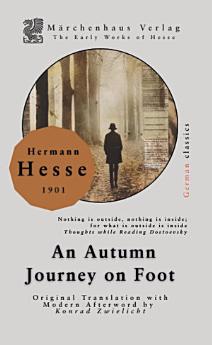An Autumn Journey on Foot
The Early Works of Hermann Hesse Book 27 · Marchen Press
eBook
92
Pages
family_home
Eligible
info
reportRatings and reviews aren’t verified Learn more
About this eBook
In 1901, a twenty-four-year-old Herman Hesse embarked on a walking tour through the autumn landscapes of rural Germany, an experience that would give birth to his early work Eine Fussreise im Herbst (An Autumn Journey on Foot). This modest travel account emerges from a critical period in Hesse's life, as he struggled to establish himself as a writer while grappling with questions of personal identity and vocation. The text offers more than mere description of countryside scenery. Through Hesse's wanderings, we see the beginnings of themes that would mature throughout his career: the seeking soul, the tension between nature and civilization, the need for solitude, and the quest for self-knowledge. This short essay was also re-printed a few years later in his 1905 collection "This Side" (Diesseits). Hesse's journey occurs at a time when German culture was experiencing the aftermath of rapid industrialization. The rural landscapes he traverses stand in contrast to urban centers expanding across Germany. His intimate descriptions of forests, rivers, and small villages reveal not nostalgia but rather an attempt to locate genuine experience in a world growing increasingly mechanical and alienated. This slim travelogue, penned after Hesse’s wanderings through the Swiss Alps and northern Italy, blends topographic observation with meditations on impermanence. Published in Basel, the narrative eschews romanticized depictions of nature, instead fixating on decaying villages and the ephemerality of human endeavors. Though minor in scope, An Autumn Journey crystallizes Hesse’s emergent philosophy of rooted transience. Its unadorned descriptions of peasant life and weather-beaten landscapes reject idealized pastoralism, privileging instead a stoic acceptance of cyclical decay. The text’s subdued tone and anti-touristic ethos would later resonate in the works of mid-century existentialists, who similarly sought meaning in mundane perseverance. This new edition features a contemporary translation of Hermann Hesse's early work, making his philosophical and existential literature accessible to modern readers. Enhanced by an illuminating afterword that focuses on Hesse's personal and intellectual relationship with Carl Jung, a concise biography, a glossary of essential philosophical terms integral to his writings, and a detailed chronology of his life and major works, this robust edition introduces readers to the brilliance of Hesse's literature. It captures the depth and nuance of Hesse’s thought and highlights its enduring impact on contemporary culture and spiritual inquiry throughout the 20th century.
About the author
Herman Hesse (1877-1962) navigated a life shaped by psychological turbulence that fundamentally transformed his literary vision following his pivotal encounter with Carl Jung's analytical psychology. After suffering a severe breakdown in 1916 amid his crumbling first marriage and the ravages of World War I, Hesse underwent intensive psychoanalysis with Jung's student J.B. Lang and later with Jung himself, sessions that would profoundly alter his creative trajectory. This Jungian influence became evident in his subsequent works, particularly "Demian" and "Steppenwolf," where the protagonist's journey toward individuation—Jung's concept of integrating the conscious and unconscious aspects of personality—emerges as a central theme. Hesse's correspondence with Jung continued for decades, their intellectual relationship deepening as Hesse increasingly incorporated Jungian archetypes, dream symbolism, and the notion of the shadow self into his narratives of spiritual seeking. The writer later acknowledged that Jung's therapeutic methods had not only rescued him from psychological collapse but had fundamentally reshaped his understanding of human consciousness, enabling him to transmute his personal suffering into the allegorical quests for wholeness that characterized his most enduring works.RetryClaude can make mistakes. Please double-check responses.
Rate this eBook
Tell us what you think.
Reading information
Smartphones and tablets
Install the Google Play Books app for Android and iPad/iPhone. It syncs automatically with your account and allows you to read online or offline wherever you are.
Laptops and computers
You can listen to audiobooks purchased on Google Play using your computer's web browser.
eReaders and other devices
To read on e-ink devices like Kobo eReaders, you'll need to download a file and transfer it to your device. Follow the detailed Help Centre instructions to transfer the files to supported eReaders.











